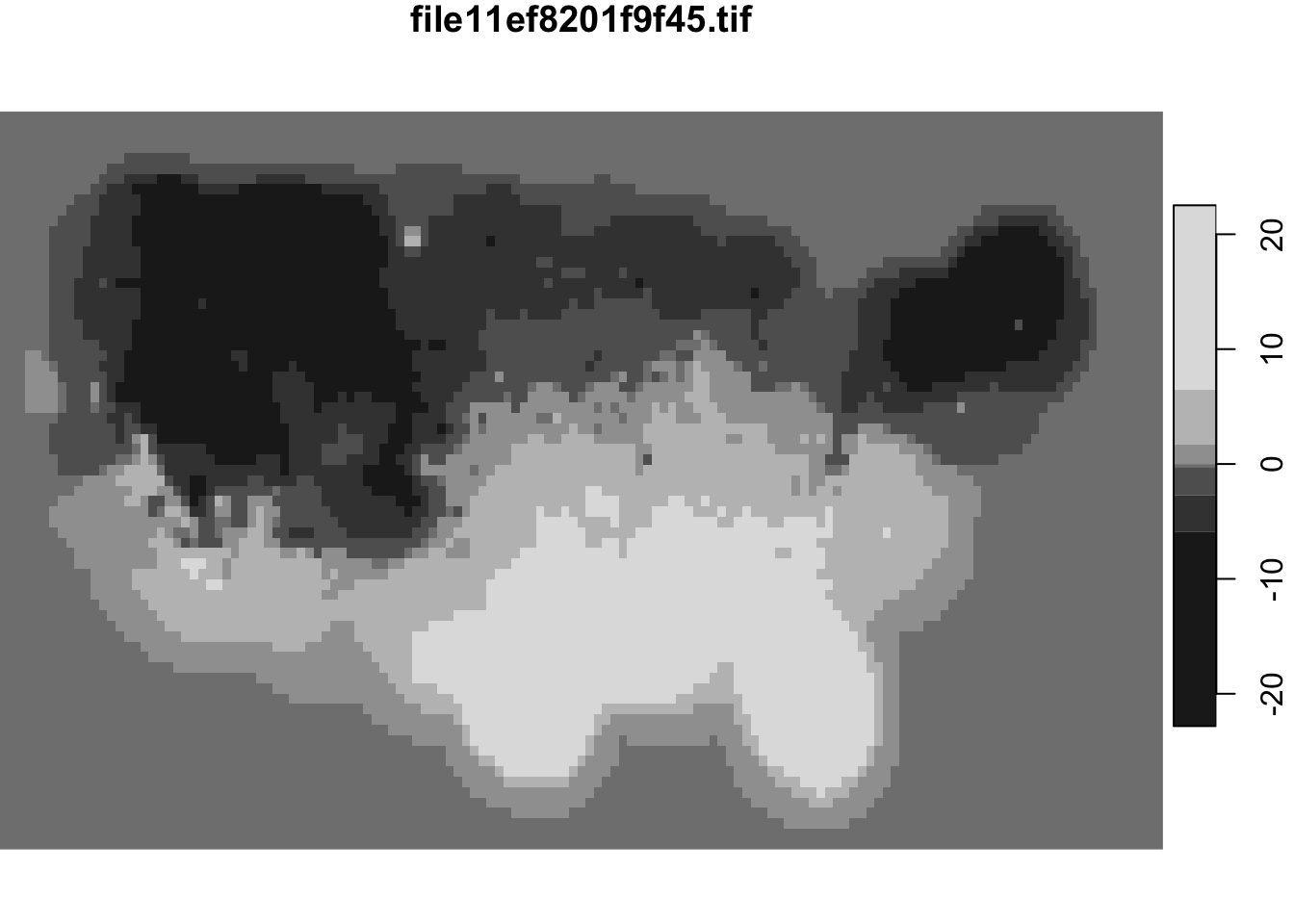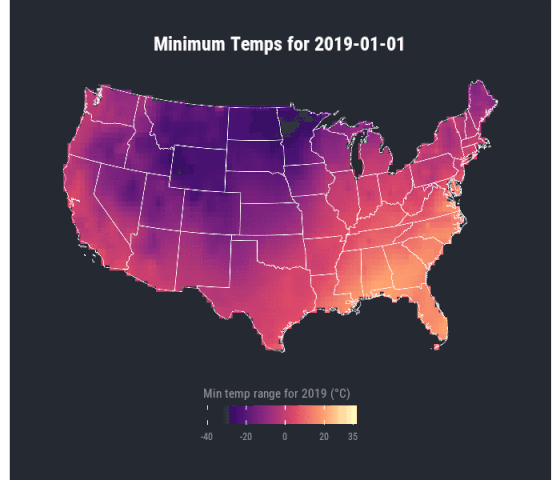7 Day 5: Raster
7.1 Technologies/Techniques
- Using
{sf}and{stars}together - Working with GeoTIFF files
- Using
{ggplot2}geom_sf()to draw basemaps and rasters together - Making animated maps with
{magick}
7.2 Data Source: U.S. Minimum Daily Temperature Rasters
The U.S. National Weather Service’s Climate Prediction Center maintains many datasets35 and I thought it’d be neat to make an animation of the daily minimum temperatures across the conterminus U.S. for 2019.
The data files are GeoTIFF36 files. They store values in a grid format (kinda like the grid we made in the previous challenge). You can store multiple “layers” (bands) in a raster images like this but the NWS CPC stores them in individual files.
Here’s what one of the images looks like:
library(sf)
library(httr)
library(stars)
library(glue)
library(stringi)
library(magick)
library(rnaturalearth)
library(hrbrthemes)
library(tidyverse)tf <- tempfile(fileext = ".tif")
download.file("ftp://ftp.cpc.ncep.noaa.gov/GIS/GRADS_GIS/GeoTIFF/TEMP/us_tmin/us.tmin_nohads_ll_20191130_float.tif", tf)
tmpstars <- read_stars(tf)
unlink(tf)
tmpstars
## stars object with 2 dimensions and 1 attribute
## attribute(s):
## file11ef8201f9f45.tif
## Min. :-22.81403
## 1st Qu.: -1.35325
## Median : 0.00000
## Mean : 0.06779
## 3rd Qu.: 0.28419
## Max. : 22.52072
## dimension(s):
## from to offset delta refsys point values
## x 1 141 -130.25 0.5 +proj=longlat +datum=WGS8... FALSE NULL [x]
## y 1 71 55.25 -0.5 +proj=longlat +datum=WGS8... FALSE NULL [y]
plot(tmpstars)
We’re going to want to clean these up a bit and mask/crop the raster to the conterminus borders, plus re-project them to a proper CRS. But, first we need to get the data and that means downloading a few hundred files. Thankfully, they’re small so this will be fairly quick.
httr::GET(
url = "ftp://ftp.cpc.ncep.noaa.gov/GIS/GRADS_GIS/GeoTIFF/TEMP/us_tmin/"
) -> res
rawToChar(res$content) %>%
stri_split_lines() %>%
unlist() %>%
keep(stri_detect_fixed, "ll_2019") %>%
stri_replace_first_regex("^[^us]*", "") %>%
walk(~{
if (!file.exists(here::here(glue("data/temps{.x}"))))
download.file(
url = glue("ftp://ftp.cpc.ncep.noaa.gov/GIS/GRADS_GIS/GeoTIFF/TEMP/us_tmin/{.x}"),
destfile = here::here(glue("data/temps/{.x}"))
)
})We could have used download.file()’s ability to download files in parallel, but it’s very likely that for ~300 files it would have consumed all available sockets on your system (it’s not a very intelligent function).
We’ll use these files in a bit.
7.3 Getting the Base Layer
We’ll use the ne_states() function to grab the U.S. and remove Alaska & Hawaii. We’ll make another, projected copy of it for use later on and also dissolve all the state borders with st_union() in yet-another copy.
7.4 Reading in Rasters
We’ll use the {stars} package to work on these rasters. Unfortunately, some of the GeoTIFF files are corrupt so we’ll have to wrap the reading operation with {purrr}’s possibly() function to avoid abrupt stops.
Believe it or not, the following block of code is super fast thanks to {stars}.
# some of the rasters have errors
safe_stars <- possibly(read_stars, NULL, quiet = TRUE)
# read them in, discarding problematic ones
list.files(here::here("data/temps"), full.names = TRUE) %>%
purrr::map(safe_stars) %>%
discard(is.null) -> temp_starsEach raster is ultimately a matrix of values. We’re going to want to keep a consistent color scale range for all the plots so we’ll need to get the range for all of the rasters. This, too, is wicked fast:
7.5 Drawing the Map
You may recall that we have multiple versions of the U.S. state polygons. We first crop the rasters with the un-projected, dissolved state border, then project the raster to the equal area projection we’ll be using and convert it to an {sf} object for plotting.
We also need to extract the date from the filename, which is preserved in the {stars} object.
We’re wrapping all this into a {magick} idiom so we can easily turn each image into an animated gif frame.
frames <- image_graph(700, 600, res = 96)
purrr::walk(temp_stars, ~{
temps <- .x
st_crop(temps, whole) %>%
st_transform("+proj=laea +lat_0=45 +lon_0=-100 +x_0=0 +y_0=0 +a=6370997 +b=6370997 +units=m +no_defs") %>%
st_as_sf() %>%
select(val=1, geometry) -> temps
temp_date <- as.Date(stri_match_first_regex(names(.x), "([[:digit:]]{8})")[,2], format = "%Y%m%d")
ggplot() +
geom_sf(data = temps, aes(fill = val, color = val)) +
geom_sf(data = states_proj, fill = NA, color = "white", size = 0.125) +
scale_fill_viridis_c(
option = "magma", limits = c(-40, 35), breaks = c(-40, -20, 0, 20, 35)
) +
scale_color_viridis_c(
option = "magma", limits = c(-40, 35), breaks = c(-40, -20, 0, 20, 35)
) +
coord_sf(datum = NA) +
guides(
fill = guide_colourbar(title.position = "top"),
color = guide_colourbar(title.position = "top")
) +
labs(
x = NULL, y = NULL,
color = "Min temp range for 2019 (°C)",
fill = "Min temp range for 2019 (°C)",
title = glue::glue("Minimum Temps for {temp_date}")
) +
theme_ft_rc(grid="") +
theme(plot.title = element_text(hjust = 0.5)) +
theme(axis.text = element_blank()) +
theme(legend.key.width = unit(2, "lines")) +
theme(legend.position = "bottom") -> gg
print(gg)
})
dev.off
gif <- image_animate(frames, fps = 5)
# save it out
image_write(gif, here::here("out/temps.gif"))
7.6 In Review
This challenge introduced the {stars} package which makes using raster day speedy, efficient, and fun! We combined that with previous knowledge of how to make other types of maps and used our {magick} powers to spin animation gold from straw data.
7.7 Try This At Home
Try doing the same process for the maximum temperature raster files and then poke at the {stars} st_warp() function and see if you can resample the grid into a finer-grained (or coarser) grid.